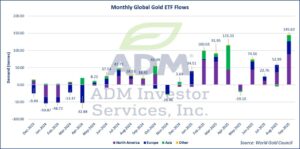MONTHLY COMMODITIES MARKET OVERVIEW
>>Read the complete October 2025 Edition HERE
KEY HIGHLIGHTS
GRAINS
Despite a bearish USDA quarterly stocks report at the end of September, prices have held in a tight, sideways trading pattern, largely due to the partial shutdown of the US Federal Government. As of this writing it would appear that this shutdown may challenge or surpass the 35-day one in 2018-2019, during the first Trump Administration. US corn inventories as of September 1 (which serve as the ending stocks fort the 2024/25 marketing year) came in at 1.532 billion bushels, up 207 million from the USDA WASDE report in September and 195 million bushels above expectations. A small portion of the higher stocks can be attributed to a 25-million-bushel upward revision to the 2024 US crop, to 14.892 billion.
Soybean prices have held up remarkably well given the fact that as of this writing China has yet to buy any from the US for the 2025/26 marketing year. Census data from China show they imported 12.9 million metric tons of soybeans in September, the second highest ever, but none came from the US. This is the first time Chinese imports from the US fell to zero since November 2018, during the first US/China trade war in President Trump’s first term. However, there are indications that China has slowed its pace of imports in recent weeks, citing high basis premiums in Brazil.
Wheat prices have continued to grind sideways to lower across the three classes, driven by higher than expected US production. In the September 30 Small Grains Report, all US wheat production was revised higher by 58 million bushels to 1.985 billion. This was 60 million above expectations and 35 million above the surveyed range. The production increase was largely due to increased harvested acres for winter wheat.
COCOA
The cocoa market extended its selloff from September into October, with the December contract falling to its lowest level in 11 months. But a 26% decline in just two months may have pushed the market too low too soon, as the market managed a recovery rally in this week. After a seasonal dry spell in August that overstayed its welcome, regular, seasonal rainfall returned to West Africa in mid-September, improving crop prospects for the 2025/26 main crop, which officially began on October 1.
COFFEE
December NY Coffee has reached another new contract high amid worries about supply from the two largest exports of coffee to the US. The 50% tariffs the Trump Administration imposed on Brazilian imports in August has resulted in a drawdown of ICE certified stocks to their lowest levels since March 2024, as buyers have looked to secure product. There was a bit of optimism towards a possible reconciliation to the tariffs after President Trump exchanged pleasantries with Brazilian President Lula da Silva at the UN and after a subsequent telephone conversation that both described in favorable terms and there were indications that the two would meet at the Association of Southeast Asian Nations (ASEAN) summit in Malaysia that starts on October 26
COTTON
December Cotton traded to new contract lows in October, taking out its post “Liberation Day” day low. Prior to the government shutdown, US crop conditions were running above average, the crop was on time, and US export sales were slow, leaving little for the bulls to get excited about besides some hope of a trade deal to be worked out between the US and China. The most recent Crop Progress report (released prior to the shutdown) showed 47% of the US cotton crop rated good/excellent as of September 28 versus a five-year average for that date of 40%.
SUGAR
March Sugar fell to new contracts low in October on expectations of ample supply from Thailand and India this year and an improving trend in Brazilian output. The most recent UNICA report showed Brazilian Center South sugar production for the second half of September at 3.137 million metric tons. Sugar’s share of crushing for the period was 51.2%, down from 53.5% for the first half of the month but up from 47.7% a year ago. Cumulative sugar production for the 2025/26 marketing year was up 0.8% from last year, a remarkable recovery from June when it was 15% behind.

CRUDE OIL
December crude oil drifted lower into mid-October, falling to its lowest level since early May, only to reverse course and rally off of news that the US had instituted a new round of sanctions against Russian oil producers. The two companies targeted by the sanctions, Rosneft and Lukoil, together produce around 5% of global oil supplies, and their exports have accounted for 47% of total seaborne exports of 3.5 million bpd, according to analytics firm Kpler. Russia has been able to circumvent previous sanctions, but the new ones may have more teeth because they could expose any company doing business with two companies to sanctions and prevent them from accessing US capital markets.
NATURAL GAS
Unseasonably warm weather in the northern US delayed and kept heating demand for natural gas at a minimum, but that scenario changed this week with the arrival of a more seasonable weather pattern in the eastern half of the country. As of October 24, the 6-10 and 8-14 day forecasts were showing normal temps across the Midwest and Great Lakes with below normal south and east from there. Above normal temps predominate in the west, including the Plains, and the 8-14 day has them moving into the western part of the Midwest.
LIVE CATTLE
The cattle and beef markets have been following seasonal trends this year. Prices rallied into Memorial Day, then fell from those highs only to gain again into the July 4th holiday. They dropped during July and rallied in August ahead of Labor Day. Prices fell again after Labor Day, but beef demand began to increase during the second week of October, as consumers increased purchases of lower-priced cuts, especially ground beef, while saving for the upcoming end-of- year holidays. Wholesalers increased purchases of beef for storage, specifically the primal sections that make up prime rib roasts, loin roasts and steaks for the holiday season. With the cattle inventory at 75-year lows, US federal cattle slaughter is down more than 7% this year from, 2024.
LEAN HOGS
The USDA Hogs and Pigs report on September 25 put the total US hog inventory as of September 1 down 1% from 2024, with breeding inventory down 2%, and the June-August pig crop down 3%. This was a friendly report, but since its release, hog and pork prices have steadily declined. The CME Lean Hog Index on September 25 was $105.00, and by October 22 it had fallen to $94.98. The CME Pork Cutout was $112.27 on September 25, and by October 22 it was $101.89.
STOCK INDEX FUTURES
Stock index futures have posted solid gains over the past month, despite a US government shutdown that has prevented the release of several important economic readings. All major indexes have reached record highs, receiving support from the AI-related stocks, expectations of more US interest rate cuts, and cautious optimism over a US-China trade deal. The Dow and Nasdaq have both gained more than 1.5% and the S&P 1.2%. The AI space has seen several high-profile investment deals, in data centers to chip manufacturing facilities to cloud service providers. The broad scope and large amounts of investment have impressed traders.
US DOLLAR INDEX
The US Dollar Index advanced more than 1% despite expectations that the Federal Reserve will cut rates at its meeting in October and again in December. The dollar has been largely supported by safe-haven flows. Political uncertainty in France and the parliamentary elections in Japan led to strong advances against the euro and yen. The dollar also saw an impressive gain following the revised Q2 GDP figures, which pointed to strong consumer spending and caused markets to scale back bets on expectations for Fed rate cuts, although 25 basis-point cuts for October and December are almost fully priced in.
EURO CURRENCY
The euro has fallen more than 1.5% since late September, with political drama in France pressing it to its lowest level since August. France has undergone multiple prime ministerial resignations in the past year, with PMs Bayrou and Lecornu both collapsing under parliamentary turbulence within months. With a public debt hovering around 114% of GDP and a budget deficit of 5 to 6%, France is under mounting pressure to implement tighter fiscal spending, but parliament is deadlocked and unable to pass reform measures.
BRITISH POUND
The British pound has fallen roughly 0.75% against the US dollar since late September, as fiscal worries have led investors to remain cautious ahead of November’s budget announcement, which is expected to include a tax increase. Britain’s borrowing in the first half of the tax year was the highest on record outside of the pandemic. Government borrowing totaled £99.8 billion in the first half of the fiscal year, £7.2 billion above the Office for Budget Responsibility’s projection. Inflation remains well above the Bank of England’s 2% target, with the reading for September coming in at an unchanged from September at an annualized rate of 3.8% after increasing 0.3% in August.
INTEREST RATES
The Treasury market has experienced a solid rally since late September, with the 10-year yield recently touching its lowest level in more than a year. This has been fueled by expectations that the Fed would cut rates in October and December. The Fed has been flying blind without official government data, including the September nonfarm payrolls report that was expected to show continued weakness in the labor market. Private data releases have suggested that the labor market remains subdued. JOLTS data was little changed in August, while ADP private payroll data showed a net decline in job growth in three of the last four months.
GOLD
Gold prices have gained more than 10% since late September, even with the sharp pullback this past week. The rally was attributed to expectations that the Fed would cut rates, strong central bank buying, and retail demand. Weak private labor data and a relatively tame inflation print from August’s PCE reading helped underpin prices, as this cemented expectations that the Fed would cut rates in October and December. Central banks added 19 metric tons of gold to reserves in August, per data from the IMF and respective central banks.
COPPER
US copper prices have increased more than 10% over the past month, supported by interest rate cuts in the US and supply disruptions around the globe. Freeport-McMoran Inc. declared force majeure at its Grasberg mining complex in Indonesia after a deadly landslide in September forced them to suspend operations. Grasberg is the world’s second largest copper mine. Disruptions continue at two other large mines, the Kamoa-Kakula in the Democratic Republic of Congo and Codelco’s El Teniente mine in Chile.
Interested in more futures market commentary? Explore our Market Dashboards here.
Futures and options trading involve significant risk of loss and may not be suitable for everyone. Therefore, carefully consider whether such trading is suitable for you in light of your financial condition. The information and comments contained herein is provided by ADMIS and in no way should be construed to be information provided by ADM. The author of this report did not have a financial interest in any of the contracts discussed in this report at the time the report was prepared. The information provided is designed to assist in your analysis and evaluation of the futures and options markets. However, any decisions you may make to buy, sell or hold a futures or options position on such research are entirely your own and not in any way deemed to be endorsed by or attributed to ADMIS. Copyright ADM Investor Services, Inc.

